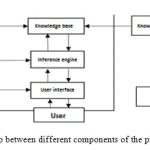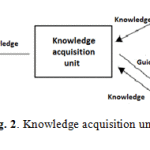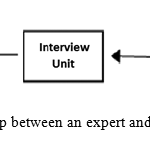Manuscript accepted on :
Published online on: 25-12-2015
Plagiarism Check: Yes
Abolfazl Ghazizadeh1*, Mehdi Dehghani1, Hamidreza Rokhsati1, Zohreh Fasihfar2
1B.S. Student in Computer Engineering, Faculty of Electrical and Computer Engineering, Hakim Sabzevari University 2Faculty member, Faculty of Electrical and Computer Engineering, Hakim Sabzevari University
DOI : https://dx.doi.org/10.13005/bpj/818
Abstract
Diagnosis of the spine diseases is usually difficult and requires the knowledge and experience of expert physicians. On the other hand, there is no specific algorithm that definitively ensures the correct diagnosis of the disease. In the present paper, a knowledge-based expert system for diagnosis of common diseases of the spine and treatment recommendations based on movement therapy was proposed. Feasibility assessment of the system was done using Beckman method. Knowledge base, as the bottleneck in the expert system which has a great impact on an accurate diagnosis, was developed in a way to support development in the future and involve all symptoms and treatment, without any interfere in the inference engine. The inference engine of the system was implemented based on leading chain rules, and deductive and inductive inferences were used in its development. Proactivity, cost reduction, combinative knowledge, and increased accessibility are some of the advantages of the developed system.
Keywords
Diagnosis; Spine; Knowledge-based expert system
Download this article as:| Copy the following to cite this article: Ghazizadeh A, Dehghani M, Rokhsati H, Fasihfar Z. Development of a Knowledge-based Expert System for Diagnosis and Treatment of Common Diseases of the Spine. Biomed Pharmacol J 2015;8(2) |
| Copy the following to cite this URL: Ghazizadeh A, Dehghani M, Rokhsati H, Fasihfar Z. Development of a Knowledge-based Expert System for Diagnosis and Treatment of Common Diseases of the Spine. Biomed Pharmacol J 2015;8(2).Available from: http://biomedpharmajournal.org/?p=3028> |
Introduction
Back pain is a common musculoskeletal disorder affecting a large part of the young and the elderly population. Acute back pain generally lasts from a few days to a few weeks, while chronic back pain persists for more than three months and if it is not treated, it would pose major risks. Back pain is usually related to disc vertebrae, muscles, ligaments, spinal cord, nerves, and internal organs such as pelvis and abdomen. Several causes have been known for back pain. Common causes of back pain include lumbar strain, nerve irritation, lumbar radiculopathy, bone rape, etc. Nowadays, artificial intelligence techniques are used in various applications in medicine. Given the complexity of diagnosis of back problems (including back pain), an expert system can be a useful approach for assessing the type and level of back problems. The expert systems are sometimes used in the clinical decision support. For example, in aiding the diagnosis and treatment of various diseases including diagnosis of high blood pressure, liver disorders, abdominal conditions, prostate diseases, lung cancer, headaches, osteoporosis, etc. Although many expert systems have been developed to help medical diagnosis, there are a few systems that exclusively diagnose and treat back pain. Medical decision-making systems get use of complex databases for diagnosis and treatment of diseases, because the database of medical experts systems should run and manage a lot of information about diagnostic procedures, symptoms, studied parameters, and treatment methods. Expert systems, as the most important application of artificial intelligence, are the best solution to complex issues that have no precise algorithm or have a deficient structure and cannot be easily solved using the conventional methods.
The science of movement therapy, as one of the branches of sports sciences, is rapidly growing now due to many advantages such as low side effects compared to medication and low cost. This science has many applications including removal of anomalies of the body, improvement of muscle cramps, etc.
Structure of the Proposed Expert System
Figure 1 depicts the structure of the proposed expert system. According to this figure, the proposed expert system consists of different components that each of them will be comprehensively discussed in next parts of this paper.
 |
Figure 1: The relationship between different components of the proposed expert system |
Knowledge acquisition
This unit is responsible for acquiring knowledge from experts and professionals and organizing them in the knowledge base. This is one of the most important parts of the experts system that the value of the system depends on. Because of the problems that professionals face in explaining their expertise, knowledge acquisition is one of the most difficult steps in development of expert systems. Information and knowledge of such persons have gained over years of experience, so that they become intrinsic and unexplainable.
As shown in Figure 2, the required information and data for the expert system are collected through experts, books, and other relevant references. After sorting, they are sent to the knowledge base.
 |
Figure 2: Knowledge acquisition unit 1 |
Methods of knowledge acquisition in this system are as follows:
- Knowledge acquisition through free interviews with movement therapists and orthopedists (experts): Interview with knowledge experts is one of the most useful methods for extraction and adaptation of new knowledge.
- Knowledge acquisition through interview helps the support of knowledge extraction without knowledge engineering. Figure 3 shows the relationship between an expert and the knowledge base.
 |
Figure 3: The relationship between an expert and the knowledge base |
Presenting a problem (a disease) to an expert and observing and recording the solution.
- Supervising and monitoring the activities of a doctor when examining a patient: In this method, when a person with back pain pay a visit to a doctor, all the actions, activities and processes that the doctor go through to treat the disease are recorded.
- Knowledge acquisition through studying books and journals of orthopedics and movement therapy and extracting knowledge from: In this method, the required knowledge is extracted after studying the relevant references and applying knowledge engineering.
Knowledge base
Knowledge base is a unit where the knowledge of an expert system is accumulated. Knowledge base is one of the most important components of an expert system, because the quality of this unit determines how the user will deal with the expert or the system.
An important part of knowledge in expert systems is heuristic. In order to develop a knowledge base, as part of the knowledge engineering operation which has a decisive role in the final result, the required knowledge is collected using the experience of an expert, books, and other scientific resources, and then the base is developed and implemented using a scientific method. In the proposed expert system in the present study, the rule-based approach was used for implementation of knowledge base. The knowledge base of this system includes a rules database which is composed of two parts of diagnosis rules database and treatment rules database.
Diagnosis rules database
This base includes a set of rules that the inference engine uses them to diagnose the disease. These rules are in the form “if …, then …” (cause and effect). Knowledge of the expert is saved as these rules in this base and inference of the expert system is done based on them and provides a proper diagnosis to the user. For instance:
- If the patient feels pain when bending the back to the sides and back, then there is a possibility of lumbar arthritis.
- If the back pain spreads to the buttocks, then there is a possibility of back strain and sprain.
Treatment rules database
There are rules in this base that the inference engine uses them to propose the best solutions to the disease. Movement therapy was tried to be applied in establishment of this database. This science treats a disease by using certain movements for that disease. This database is divided into two parts of written information and visual information, which shows how the movements should be performed. This rules are in the form of “if …, then …” (cause and effect). For example:
- If a patient has back sprint, then putting a hot water bag on the back is recommended.
- If the patient suffers from scoliosis, then hanging on the Swedish horizontal bar is recommended in a way that the right hand on the upper bar and the left hand on the lower bar are fixed.
Inference engine
Inference engine in a knowledge-based expert system involves techniques for problem solving. In other words, inference engine is a program that analyzes the rules and knowledge accumulated in the knowledge base and provides a logical conclusion. In fact, inference engine is the backbone of an expert system, because it includes the techniques that the expert system solves the problem by using them. Given the predictability nature of the desired problem, the leading inference chain was used for simulation of reasoning ability and the expert decision and also for deductive and inductive inference. This inference engine was implemented in C# based on fuzzy logic.
In the proposed system, the inference engine selects a rule for testing and examines whether the condition(s) of this rule are valid or not. These conditions are examined through asking the users some questions. When the conditions of a rule are valid, then the result of that rule will be correct and valid. Therefore, this rule is activated and its result is added to the knowledge base. In addition, this result is displayed on the user interface as information in each stage.
The duties of this part are done in three steps. In the first step, the acceptable and possible hypotheses and theories are sent to the second step. By evaluating the theories and hypotheses, it is tried to limit the range of diseases in the second step, and then searching for the correct disease in their hierarchy continues. In the final step, when the type of disease is diagnosed, the proper treatment is provided to the patient (user).
User interface
The success of an expert system often depends on the quality of the user interface which is developed to help the user to use the system. Given the high graphical interface in C# and also very low error rate of this programming language, it was used for development of the user interface.
Conclusion
The results of the present study show that the expert system closely follows the procedure of diagnosis and providing the treatments by a doctor, unless when the disease is uncommon and rare or when the user does not provide the system with true and genuine answers. This system follows the probabilities over 50% in each stage and, as a result, the intended disease is very unlikely to be eliminated from the remaining possibilities list. Since the treatment rules database involves the knowledge on movement therapy science and this this science is growing and changing rapidly, the knowledge base needs to be updated periodically.
References
- Shadmani, E and Mosadeghkhah, M. Development of an expert counseling system for repair and troubleshooting electrical circuits at missile site, The Third National Conference on Maintenance 2005.
- M, Toth-Tascau, D.I. Stoia, D. Andrei, Integrated Methodology for a Future Expert System used in Low Back Pain Management, 7th IEEE International Symposium on Applied Computational Intelligence and Informatics, Timisoara, Romania, 2012.
- M, Kazemi. Z, Principles and Foundations of Expert Systems; Iran University of Science and Technology, 2010.
- Y, Afsharmand. Z, Corrective Exercises; Hatmi Publication, First Edition, 2013.
- Folorunso, I. O, Abikoye, O. C, Jimoh, R. G, Raji, KS, A Rule-Based Expert System for Mineral Identification, Journal of Emerging Trends in Computing and Information Sciences, 2012.
- M, Yazdian. R; Ghalenoiy. M, Proposing a risk management expert system for banking; International Conferences Center, Tehran, 2013.
- M, Moghadam. N, Kabir. A, Expert system of feeling detection from the video picture of face, Journal of Iran Computer Association, 2006.
- A, Vaezadeh. S, Caro. L, Proposing a decision expert system for preliminary design of electrical machines, Second International Conference on Information Technology, Amirkabir University of Technology, Tehran, 2005.
- Claudio Urrea, Gloria Henríquez, Marcela Jamett, Development of an expert system to select materials for the main structure of a transfer crane designed for disabled people, Elsevier, 2014.
- N, Application of Pissman software for determining the quality of pistachio, Journal of Agricultural Sciences and Natural Resources, Volume XIII, 2006.
- M, Ghat-iy. M, Development of a decision support expert system for guiding the travelers, International Conference on Research in Operation, Babolsar, Iran, 2009.
- F, Kabirkoohi. N, Proposing an intelligent system for helping the tourists to find the most suitable travel destination, Second National Conference on Tourism and ecotourism of Iran, 2013.








